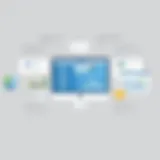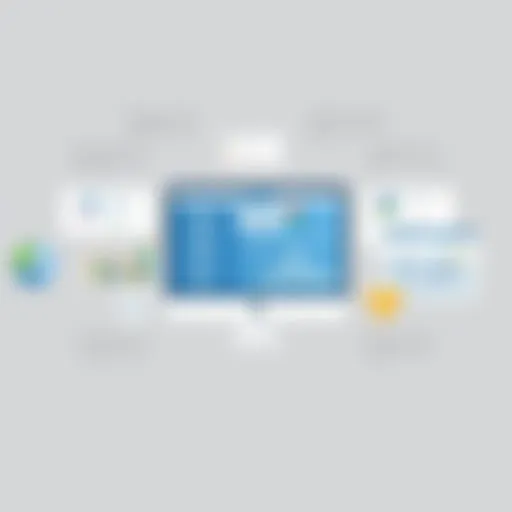Discovering Effective Alternatives to TeamViewer


Intro
In the age of digital interactions, remote access tools have become backbone essentials for many professionals and organizations. The need for seamless connectivity across distances has never been greater, especially as teams and clients are scattered around the globe. While TeamViewer has been a prominent name in this domain, several alternatives offer competitive features that may better align with varied user requirements. Whether it's about enhanced security measures, cost considerations, or specific functionalities, exploring alternatives unlocks new possibilities for optimizing remote access capabilities.
This article will guide you through the landscape of remote access software, beginning with a solid overview of this category, before diving into a data-driven analysis showcasing key metrics and comparative insights about leading options available today.
Software Category Overview
Purpose and Importance
Remote access software serves an invaluable role in modern work environments. As more companies embrace remote working strategies, the demand for tools that facilitate access to internal systems and collaboration from afar has surged. This category of software not only empowers employees to work from any location but also enables customer support teams to assist clients effectively.
Security holds a lot of weight in this arena. With sensitive data often involved, choosing the right software becomes crucial. A user may find that some alternatives prioritize security features over user-friendliness, while others may be more cost-effective but lack comprehensive protection.
Current Trends in the Software Category
Recent trends include increased focus on data privacy, integration capabilities with cloud environments, and real-time collaboration tools. Users now expect solutions to incorporate advanced security features like multi-factor authentication and end-to-end encryption. Also, with the rise of remote workforces, many companies are looking for comprehensive support solutions that can adapt independently to changing team structures.
"The right remote access tool can significantly enhance productivity and streamline workflows by ensuring employees have the access they need, exactly when they need it."
Data-Driven Analysis
Metrics and Criteria for Evaluation
To evaluate which software alternatives to TeamViewer are genuinely worthy, several metrics come into play:
- User Experience: Ease of use can be a determining factor that impacts overall productivity.
- Security Features: Checks for encryption protocols and how the software handles sensitive data.
- Pricing Structure: Understanding the cost vs. the features offered is vital for budget-conscious users.
- Customer Support: How responsive and helpful the support channels are when users encounter issues.
Comparative Data on Leading Software Solutions
A thorough comparison of alternatives offers critical insights. Below are some key players in the remote access software space:
- AnyDesk - Noted for its low latency and straightforward interface, making it popular among freelancers and small businesses.
- LogMeIn - A feature-rich option that provides extensive support tools and strong security, often favored by larger organizations.
- ConnectWise Control - Aimed at IT professionals, this platform offers robust tools suited for troubleshooting and management.
The decision to switch or remain with TeamViewer can hinge on aligning software choices with specific transactional needs and a deep understanding of available options. As the demand for remote working tools continues to expand, the alternatives presented in this guide will help users make informed decisions.
Overview of Remote Access Software
Remote access software has become a game changer in how we work, communicate, and collaborate. Its importance is felt in every corner of the business world, enabling employees to connect and interact with both colleagues and clients, regardless of geographical boundaries. With more companies shifting toward remote work environments, understanding remote access software is vital. This article highlights the key aspects that make such software indispensable for modern organizations.
Definition and Purpose
Remote access software allows a user to control a device from another location, giving the capability to access files, applications, and even troubleshoot issues without being physically present. Whether it’s an employee needing to connect to their office computer from home or an IT technician providing support to a client’s system, the need for such technology is clear. The main purpose is to simplify workflows and enhance productivity by empowering individuals to maintain access to necessary resources from virtually anywhere.
Key Features to Consider
When seeking remote access solutions, several features come to the forefront. Here’s a breakdown:
Cross-Platform Compatibility
Cross-platform compatibility refers to the ability of remote access software to function across various operating systems like Windows, macOS, and Linux. This attribute is essential because organizations use diverse systems, and having software that seamlessly integrates with them can save time and prevent frustration. It can be a great choice for businesses aiming for versatility, allowing team members to connect whichever system they prefer. A unique feature of this compatibility is leverage across devices—this means that you could start a task on your laptop and finish it on your tablet without hiccups. However, one has to keep in mind that some more exclusive features may be available only on certain platforms, which might limit access choices in specific contexts.
User Interface Design
The user interface design significantly influences how easy it is for users to navigate the software. A well-structured interface can reduce the learning curve for new users, making it more palatable for less tech-savvy individuals. This simplicity brings added value, especially in emergency cases where quick access is crucial. Unique elements like drag-and-drop capabilities or customizable toolbars can elevate the user’s experience. On the flip side, overly simplistic designs can sometimes mask powerful features that require a deeper understanding, potentially leaving users unaware of full capabilities.
Support and Documentation
In the realm of technology, robust support and thorough documentation can mean the difference between success and frustration. Excellent support, whether through chat, email, or phone, provides users with peace of mind, knowing help is readily available. Moreover, well-written documentation and tutorials can assist users in understanding the software’s intricacies, aiding in troubleshooting and feature utilization. Nevertheless, some solutions may boast extensive documentation but lack timely support, which can be disheartening during urgent situations.
Security Features
Security features are non-negotiable in the selection of remote access software. Many companies handle sensitive information and need strong measures to prevent unauthorized access. Encryption, multi-factor authentication, and session logging play crucial roles in ensuring that data remains protected. The highlight of this requirement is that enhanced security not only preserves data integrity but also builds user trust, which is essential for long-term software adoption. However, with enhanced security often comes added complexity, which can deter users who seek simplicity.
Remote access software continues to evolve, adapting to the needs of modern users. By understanding its core components, organizations can make informed choices in selecting solutions that align with their operational goals. Through this exploration, we’ll uncover a range of alternatives that provide not only similar functionalities but also distinct advantages tailored to meet specific demands.
Evaluating TeamViewer
In the landscape of remote access software, evaluating TeamViewer is essential for anyone considering their options. Regardless of whether you are a business professional needing to support colleagues remotely or an IT expert managing multiple systems, understanding TeamViewer's strengths and weaknesses can help clarify if it's the right fit for your needs. This analysis focuses on specific elements such as reliability, comprehensiveness, and efficiency—all vital considerations that come into play when selecting an effective remote access solution.
Strengths of TeamViewer
Wide Adoption and Trust
The widespread use of TeamViewer speaks volumes about its reliability. Many organizations opt for this tool because it has built a solid reputation over the years. This trust is cultivated through consistent performance and constant updates that enhance security and functionality. In a world where cybersecurity is no joke, knowing that TeamViewer has safeguards in place can be a comforting thought. However, the flip side is that its popularity can sometimes lead to performance strain during peak hours due to the high number of users.
Comprehensive Features Set
TeamViewer offers an extensive array of features that cater to a variety of user needs. From file transfer capabilities to multiple-session handling, it allows for seamless collaboration across different locations. Not to mention, the inclusion of features such as remote printing and cross-platform connectivity positions it as a multifaceted tool suitable for diverse audiences—from small businesses to large enterprises. However, all these features can be overwhelming, especially for new users unfamiliar with such a broad range.
Ease of Use
One of TeamViewer's standout characteristics is its user-friendly interface. Even those who are not particularly tech-savvy find that they can navigate its functionalities with relative ease. This straightforward accessibility allows users to focus more on getting work done than on learning how to use the software itself. Conversely, this simplicity sometimes leads to underutilization of more advanced features, meaning users might miss out on important tools that could streamline their processes further.
Limitations of TeamViewer


Cost Considerations
When it comes to cost, TeamViewer can be a hefty investment, especially for smaller businesses or individual users. The subscription-based model can add up over time, which might make some users ponder whether they are truly getting their money’s worth. The pricing structure tends to favor larger organizations, pushing freelancers and small startups to reconsider if they need all the bells and whistles that come with TeamViewer.
Performance Variability
Another factor to weigh is performance variability. Depending on internet speed and the number of active connections, users may experience lag or interruptions during sessions. This inconsistency can be a dealbreaker for those depending on smooth, uninterrupted access, especially in time-sensitive situations. Such potential setbacks can lead some to search for alternatives that offer more stable performance.
Overhead for Basic Tasks
For users focused on basic remote support tasks, TeamViewer sometimes comes with unnecessary overhead. The extensive features, while beneficial in many contexts, can also complicate simple interactions. This bloat can detract from the overall user experience, making routine tasks feel more cumbersome than they need to be. For those who just need fundamental remote access capabilities, simpler solutions might be worth considering.
Evaluating TeamViewer provides insights that aid in making an informed choice for remote access solutions, balancing strengths with practical limitations.
Criteria for Best Alternatives
When it comes to choosing an alternative to TeamViewer, there's more than meets the eye. Each user's situation is unique, and the right software must reflect that diversity. Understanding the criteria for these alternatives not only facilitates a pragmatic selection but ensures that the chosen tool meets the specific demands of remote access tasks. The following factors stand out as critical in weighing the options:
Cost-Effectiveness
In many cases, especially for smaller businesses and solo professionals, budget constraints are a significant concern. Cost-effectiveness doesn't just refer to the initial price but encompasses the overall value received from the platform. Hidden fees, recurring charges, or limitations on features can often turn an initially attractive proposition into an unexpected expense. Seeking a solution that balances affordability with robust functionality is key.
It's essential to dissect the pricing models of these alternatives:
- Flat Rate vs. Subscription: Does the service offer a one-time payment option as opposed to ongoing monthly subscriptions? Some users might prefer to pay upfront to avoid ongoing costs.
- Scaling Costs: As businesses grow, will the remote access solution scale accordingly, or will prices inflate drastically?
- Comparison of Trial Periods: Some platforms might provide free trials. Taking advantage of these can give insights into whether the costs will translate into fulfilling needs before making an investment.
Performance Reliability
Performance should always be high on the list of considerations. The frustrating feeling of lag, dropped connections, or unpredictable quality can be a deal-breaker. Users should gauge how reliably each alternative performs under various conditions. Factors worth considering include:
- Connection Stability: How steadfast is the connection? Testing the software in different environments can shed light on its reliability.
- Speed and Response Time: A good indicator of a robust application is quick response time. Delays can create barriers, especially in collaborative tasks.
- Support for Multiple Users: If working with a team, ensure the tool can handle multiple simultaneous connections without performance dips. Performance reliability contributes to seamless remote access experiences, a necessary aspect especially for professionals in high-stakes environments.
User Experience and Support
Intuitive design and effective support are essential. A clean user interface can make the difference between a frustrating experience and efficient navigation. Consider these elements:
- Guide and Documentation: Comprehensive resources pave the way for ease of use. Good documentation not only helps when setting up the system but can solve issues that arise during use.
- Support Availability: What kind of support options does the alternative offer? 24/7 live support might hold significant value for those who work unconventional hours or deal with emergencies.
- User Community: An active user community on platforms like Reddit can enhance the experience. Sometimes peer advice or shared experiences can lead to quicker resolutions.
"The right support features can cut downtime in half; it can be the light at the end of the tunnel during a tech crisis."
By keeping these criteria in mind, users can navigate the myriad of available options more effectively, ensuring that the alternative they select genuinely serves its intended purpose.
Exploring Alternatives
The exploration of alternatives to TeamViewer is crucial in today’s remote working environment where the demand for efficient, user-friendly, and secure software is higher than ever. Users no longer settle for one-size-fits-all solutions; they need tools that adapt to their specific requirements, whether it be cost, performance, or usability.
In this section, we’ll look at prominent alternatives and understand their features, pricing, and target demographics. This analysis not only helps individuals or businesses make informed decisions but also broadens the scope of how remote access software can cater to various user needs.
AnyDesk
Key Features and Usability
AnyDesk stands out for its outstanding performance and smooth usability. One particular aspect that draws users in is its exceptional low latency, which means that the connection is fast and responsive, just like if you were sitting right in front of the remote computer. The simple interface makes it accessible for both technical and non-technical users alike, ensuring that anyone can jump right in without much ado.
For instance, it employs a unique proprietary codec called DeskRT, optimized for remote desktop applications. This codecs helps in efficient data transmission, ensuring high quality video with minimal data usage. Such characteristics make AnyDesk a popular choice, especially for users who value speed and efficiency in their remote sessions.
Cost and Availability
When we talk about cost, AnyDesk offers a blend of affordability and robust functionality that appeals to many users. There’s a free version suited for personal use, which is a major selling point for individuals or small businesses looking to keep costs down.
Moreover, even their paid plans are competitively priced compared to other options. The availability across platforms like Windows, macOS, and Linux only adds to its appeal, making it easily accessible regardless of your device. This flexible pricing model lets users choose what’s best based on their specific needs.
Target Audience
AnyDesk specifically targets freelancers, small businesses, and educational institutions which greatly appreciate its economical and efficient remote access solution. It’s not just about hitting a price point; it’s also about addressing the needs of people who might not have extensive IT resources.
However, while it has many advantages, larger enterprises with more complex requirements sometimes find it lacking in advanced administrative features, which can be a deal-breaker.
Chrome Remote Desktop
Setup and Configuration
Chrome Remote Desktop easily simplifies the setup and configuration process. Users must only have a Google account and the Chrome browser. This makes it a preferred option for those who value simplicity and speed in getting started. The setup is straightforward and doesn’t require much technical know-how.
One of its unique features is the ability to access machines remotely without needing any software download, which is quite convenient. But, if you’re looking for advanced features, you might find the basic configuration somewhat limiting.
Limitations and Strengths
Among its strengths, Chrome Remote Desktop is exceptional for personal use due to its easy setup and zero cost. However, it comes with limitations when it comes to collaboration or multi-user scenarios.
Users are often left wanting more capabilities in terms of sharing control or integrating with other tools. Relying on a browser for full functionality can also lead to performance hiccups in demanding tasks.
User Feedback
Users often appreciate the convenience and no-cost aspect of Chrome Remote Desktop. However, feedback also highlights a desire for more features, as the tool feels quite basic when compared with solutions like AnyDesk or TeamViewer. It’s suited more for casual users rather than professionals who need extensive remote access capabilities.
LogMeIn


Pricing and Plans
LogMeIn enters the conversation with a pricing structure that, though sometimes seen as steep, offers considerable returns in terms of features and support. Various plans create opportunities for scaling; as businesses grow, their remote access needs evolve.
The uniqueness of LogMeIn lies in its feature-rich offerings, including file transfer, cloud storage integration, and even remote printing. It does cater to a clientele that values comprehensive service over sheer cost.
Suitability for Businesses
LogMeIn is generally well-suited for businesses due to its extensive security features and robust administrative tools. It lays down a solid framework for enterprise needs. If companies are looking for something with scalability and more advanced functionalities like multi-user access, LogMeIn fits that bill perfectly.
However, the cost can be a downside for smaller companies, which might find it challenging to justify the expense, especially when free alternatives exist.
Comparison with TeamViewer
When comparing LogMeIn with TeamViewer, it’s clear both have distinct advantages. LogMeIn tends to shine in its stability and management tools, providing businesses with an organized way to manage multiple users.
TeamViewer, conversely, sometimes edges out in terms of user interface and ease of access, appealing to a different user base. Ultimately, the choice between the two often boils down to specific user needs, budget, and intended use cases.
Parsec
Gaming vs General Use
Parsec has carved out its niche primarily in the gaming domain, focusing on offering high-performance remote gaming experiences. It allows users to play games remotely as if they were on a local machine, which is a unique characteristic not found in many alternatives.
For general use, however, Parsec is in the early stages of being adopted. It’s great for gamers, but less so for companies that need remote access for non-gaming tasks, limiting its overall viability.
Performance Metrics
When discussing performance metrics, Parsec excels in delivering high frame rates, making it seamless for users who play resource-heavy games online. This performance aspect makes it popular in the gaming community.
The downside is that for standard remote desktop tasks, it may feel somewhat excessive or complicated for tasks as simple as accessing files on a remote machine.
User Community Insights
The user community surrounding Parsec reveals a group passionate about gaming. They often share tips and support through forums, creating a vibrant ecosystem of shared knowledge. However, general users may not find as many resources for non-gaming applications, presenting a potential hurdle.
RemotePC
Affordability and Value
RemotePC leans heavily on affordability, making it accessible for many users looking for budget-friendly options. It provides a range of pricing plans that allow customers to pick what they need without the unnecessary bells and whistles.
The value derived from its straightforward functionalities makes it appealing for freelancers and small businesses, who often don't require the extensive capabilities offered by pricier software.
Target Demographics
RemotePC resonates well with users who are looking for simple and effective remote access without spending much. It appeals particularly to small to medium businesses and individuals who want to maintain a professional edge without breaking the bank.
However, larger corporations might not find it adequate due to the lack of advanced features typically necessary for enterprise-level operations.
Core Functionalities
In discussing core functionalities, RemotePC offers essentials like file sharing, remote access, and basic collaboration features. These capabilities form the cornerstone of its utility, making it snappy and efficient.
Nonetheless, it lacks certain advanced functionality that helps with team collaboration or integration with third-party tools, which can be a drawback for users wanting more from their remote access software.
Comparative Analysis
In the landscape of remote access software, comparative analysis plays a key role in determining the right tool for specific needs. This section thoroughly examines the different facets of alternatives to TeamViewer to provide a clear picture for users looking to switch or upgrade. Each remote access solution has its distinct strengths and weaknesses, and understanding these nuances can make or break productivity in a working environment.
When engaging in a comparative analysis, it’s essential to consider various elements. Key features like performance reliability, cost, user experience, and support services are paramount. Each of these areas can influence a user's or a company’s decision-making journey. This analysis also allows for an apples-to-apples comparison, presenting data that leads to informed choices. Moreover, analyzing how each software stacks up against TeamViewer brings perspective, helping to identify which solutions meet unique operational demands.
Feature by Feature Comparison
When assessing different remote access tools, a feature by feature comparison sheds light on vital specifications and functionality. Features like file transfer speed, connection quality, and multi-device support should be at the forefront. For instance, AnyDesk is renowned for its low latency and high-speed file transfer, making it an attractive option for those prioritizing efficiency. In contrast, Chrome Remote Desktop offers convenient integration with Google services, appealing to users already in that ecosystem.
Additionally, consider the availability of features like remote printing, session recording, or online collaboration. LogMeIn, for example, boasts robust collaboration tools, suitable for businesses looking for efficient teamwork solutions. Meanwhile, Parsec has carved a niche largely in gaming, hence its performance metrics tailored for high-resolution graphics and low input lag. Users must align their feature requirements with their primary use case—whether for gaming, education, or tech support—to maximize the potential of their remote access tool.
User Rating and Reviews
User feedback can be a treasure trove of information on how a software performs in real-world environments. Diving into user rating and reviews provides insights that marketing materials might not convey. Many platforms are brimming with discussions and criticisms both good and bad, from experiences shared on Reddit to critique threads on tech forums.
For example, some users laud RemotePC for its user-friendly interface and affordability, while others point out limitations in customer support, which can be crucial during downtime. Conversely, AnyDesk often receives high marks for its performance but can evoke mixed feelings regarding its security features.
Take note of recurring themes in the ratings. Maybe a certain program is efficient but lacks comprehensive support documentation, or perhaps it offers great features but at a higher price point. By considering this feedback carefully, potential users can weigh their options more judiciously and find a remote access solution that is not merely a substitute for TeamViewer but a better fit for their specific circumstances.
"User reviews can reveal hidden gems or critical drawbacks. They may reflect what a feature list alone can't convey."
In sum, a thorough comparative analysis is an indispensable step in selecting suitable alternatives to TeamViewer. It helps navigate through an array of features, ratings, and user experiences to make a well-informed choice.
Potential Use Cases for Alternatives
In the realm of remote access technology, understanding the specific scenarios in which these tools can be effectively utilized is crucial. Alternatives to TeamViewer go beyond just enabling a connection; they can transform workflows, facilitate collaboration, and enhance support systems. This section delves into the diverse use cases for these alternatives, shedding light on their significance across various sectors.
Remote Support for Technicians


For technical support teams, remote access alternatives serve as valuable tools when addressing client issues. Imagine a technician sitting in a completely different location from the equipment they need to troubleshoot. With alternatives like AnyDesk or LogMeIn, they can promptly connect to the client's device, performing necessary diagnostics without the need for lengthy phone calls or on-site visits. This not only saves time but also boosts customer satisfaction.
Apart from speed, these tools provide a level of adaptability; technicians can manage software updates, configures settings, and even guide users through complex processes without being physically present. Particularly in industries that depend on quick resolutions—like IT services or customer support—having reliable remote access can enhance service delivery and customer trust.
Collaborative Work Environments
In today’s distributed work culture, finding effective ways to collaborate can be a challenging puzzle. Alternatives to TeamViewer, such as Chrome Remote Desktop and Parsec, can facilitate a more engaging teamwork experience. They allow teams to share screens, edit documents in real-time, and host virtual brainstorming sessions.
These tools also allow for the simultaneous input from multiple users, which can lead to increased creativity and solution generation—vital in sectors like marketing, design, and software development. With remote teams often blending across time zones and locations, being able to connect and share insights in real-time cannot be understated.
Educational and Learning Platforms
When it comes to the educational landscape, remote access solutions can considerably enhance the teaching and learning experience. Educational institutions and online platforms leverage these technologies to connect students with teachers, regardless of geographical barriers. This offers a more inclusive learning environment.
Tools like RemotePC provide the capacity for educators to interact live with their students, share resources instantly, and assist with hands-on exercises. Not only do these tools help in presenting courses, but they also support tutoring sessions where students can receive one-on-one guidance.
Overall, as educational methods continue to evolve, these alternatives to TeamViewer are pivotal in creating robust learning ecosystems.
"Remote access tools are not just about connectivity; they represent a shift in how we approach collaboration, support, and education across the globe."
In each case, whether for support technicians fixing issues, teams collaborating across distances, or educators guiding learners, the adaptability that remote access software brings can redefine productivity and efficiency in various applications.
Future Trends in Remote Access Technology
As we move further into the digital age, the demand for remote access technology continues to evolve. This section will dive into some pivotal future trends shaping the landscape of remote access solutions, emphasizing their importance for users and organizations alike.
Integration with AI
Artificial Intelligence is making strides in various sectors, remote access being no exception. The incorporation of AI technologies into remote access tools significantly enhances their functionality. For instance, intelligent algorithms can streamline troubleshooting processes by diagnosing issues in real-time. Imagine a remote support session where AI suggests solutions based on historical data and user behavior. This can drastically reduce downtime for both technicians and users.
Moreover, AI chatbots can handle basic inquiries or tasks, leaving human operators to tackle more complex issues. This not only improves efficiency but also provides users with quicker responses, enhancing overall satisfaction with remote access services.
Enhanced Security Measures
With increasing concerns about data breaches and cyber threats, security in remote access technologies will continue to be a top priority. Future solutions are likely to implement multi-factor authentication, biometric identification, and advanced encryption techniques to protect sensitive information. These measures are crucial as organizations often handle confidential data during remote sessions.
Furthermore, continuous monitoring for suspicious activity is becoming more prevalent. By employing machine learning models, remote access providers can flag unusual patterns that may indicate a security threat, allowing for swift action. The focus on strengthening security protocols not only safeguards data but also builds user trust—a key factor for businesses when selecting a remote access solution.
Cross-Device Compatibility
As technology progresses, users increasingly work across multiple devices—be it laptops, tablets, or smartphones. The future of remote access will heavily emphasize cross-device compatibility, enabling seamless transitions between devices without interruption.
Imagine a scenario where a user starts a session on a desktop, quickly switches to a tablet, and continues without losing the thread of their work. This flexibility is essential in today’s fast-paced world, where agility can mean the difference between seizing an opportunity or missing it. Remote access providers that prioritize this feature will likely gain a competitive edge, appealing to a broader audience who seek ease of use across platforms.
In summary, the evolution of remote access technology is not just about enhancing performance; it’s about aligning with the needs and expectations of users today. From AI integration to robust security measures and cross-device functionality, these trends will help shape a remote access landscape that is not only more efficient but also significantly more secure and user-friendly.
Making Your Choice
Making a selection when it comes to remote access solutions is not just about picking the first option that pops up in your search results. The nuances involved in this process can mean the difference between frustration and efficiency in your day-to-day operations. Drawing from the overarching criteria laid out earlier, it's critical to delve deep into understanding what works best for your specific environment.
Choosing the right tool requires careful thought about various factors including your unique requirements, budget, and intended use. Every person or business will have different demands; for instance, someone who needs to assist colleagues remotely may prioritize user interface simplicity over a wide range of features. A company managing multiple systems might find adaptability and security as their main focus.
Moreover, a well-informed choice can not only save precious time but can also foster better collaboration and productivity within teams. It can empower users to easily resolve technical issues, while also offering seamless communication features that enhance teamwork. So let’s dive into the components that will help you better comprehend your needs.
Understanding Your Needs
Understanding your needs might sound straightforward, but it often requires a good deal of introspection and forecasting. Begin by assessing the main reasons you are seeking alternatives to TeamViewer. Are you facing budget constraints? Are you unhappy with certain aspects of TeamViewer, like speed or reliability? Take the time to jot down these thoughts.
Here are a few key points to consider when outlining your needs:
- Primary Use Case: Determine the core functions for which you need remote access. Is it for technical support, collaborative projects, or something else?
- Team Size: Factor in how many people will be accessing the platform. Pricing generally varies based on the number of users, so it’s important to know your scale.
- Device Compatibility: Will you require cross-platform functionalities? Ensure any alternative supports the Operating Systems you are using.
- Frequency of Use: Analyze how often you will utilize remote access. If it’s sporadic, you might opt for a more cost-effective solution.
Taking the time to create a clear picture of what you need can guide you in narrowing down your choices effectively.
Testing Alternatives
Before making a final decision on any alternatives, it’s wise to invest some effort into testing various options. Just as a wise shopper wouldn’t buy shoes without trying them on, it would be foolhardy to commit to software without experiencing its features first-hand.
Here are some strategies to consider while testing alternatives:
- Free Trials: Many remote access tools offer free trials for a limited time. Dive in and experiment with the features. This hands-on experience will provide direct insight into usability and performance.
- User Reviews and Testimonials: Don’t underestimate what the community has to say. Websites like Reddit or specific tech forums can provide rich narratives on user experiences, especially regarding reliability and customer service.
- Compare Features Side by Side: Create a comparison chart highlighting the features that are most important to you across multiple platforms. It saves time and offers a visual representation of strengths and weaknesses.
- Support Experience: Test out customer service channels by reaching out with inquiries. This helps you gauge their responsiveness and level of expertise, an often overlooked aspect when making a choice.
By meticulously examining your needs and trialing potential alternatives, you position yourself to make a choice that not only aligns with your objectives but also enhances your workflow in meaningful ways.
Ending
In wrapping up our exploration of alternatives to TeamViewer, it’s essential to acknowledge how varied the landscape of remote access software has become. Enterprises and individuals alike have their unique needs shaped by budget, security requirements, and specific functionalities. The growing universe of options allows users to find tools that not only match their technical expectations but also align with their work culture and cost considerations.
Summarizing Options
When considering the alternatives discussed, each solution presents distinct advantages:
- AnyDesk: Embraces seamless cross-platform compatibility and a user-friendly interface.
- Chrome Remote Desktop: Offers a no-cost solution with strengths in simplicity and integration with Google services.
- LogMeIn: Perfect for businesses requiring robust capabilities at a premium price point.
- Parsec: Tailored specifically for gamers, renowned for its low-latency remote access.
- RemotePC: Recognized for its affordability and practical functionality tailored to personal and business use.
These options are not just about comparing price tags or snazzy features; they’re about finding the right fit for your remote access needs. Depending on whether you’re a tech-savvy specialist or managing a team of varied IT experience, the choice might differ significantly. Evaluating how these solutions integrate into workflows and how they contribute to enhancing productivity can lead to a more informed decision.
Final Recommendations
As you contemplate the best remote access tool, here are some takeaway pointers:
- Evaluate Your Needs: Conduct a needs assessment. Consider the level of access required, the types of devices you need to support, and user skill levels.
- Set a Budget: Understand your financial limits. While some tools offer free versions, the capabilities may be limited, which could affect performance in demanding scenarios.
- Trial Periods: Before making a commitment, utilize trial versions where available. This hands-on experience might unveil features or limitations not apparent in marketing materials or reviews.
- Community Feedback: Engage with online forums such as Reddit or dedicated tech communities to gather insights from other users. Often, firsthand experiences can highlight critical aspects that articles miss.
Choosing the right remote access solution is less a one-size-fits-all situation and more an individualized journey. The importance lies in matching your requirements with the capabilities of the software. Taking the time to scrutinize these alternatives will ultimately grant you better functionality and satisfaction in your remote access endeavors.





